Research on the CO2 Emission Characteristics of a Light-Vehicle Real Driving Emission Experiment Based on Vehicle-Specific Power Distribution
Abstract
:1. Introduction
2. RDE Test Method
2.1. Test Equipment and Process
2.2. Experimental Data Processing
3. Results and Discussion
3.1. Vehicle Acceleration and Acceleration Distribution
3.2. CO2 Emission Factor
3.3. CO2 Emission Based on VSP
4. Conclusions
Author Contributions
Funding
Conflicts of Interest
References
- Ministry of Ecology and Environment of the People’s Republic of China. China Mobile Source Environmental Management Annual Report. 2021. Available online: http://www.gov.cn/xinwen/2021-09/11/content_5636764.htm (accessed on 2 April 2023).
- Huang, Z.; Tang, D. Estimation of Vehicle Toxic Air Pollutant Emissions in China. Res. Environ. Sci. 2008, 21, 166–170. [Google Scholar] [CrossRef]
- Li, T.; Chen, X.; Yan, Z. Comparison of fine particles emissions of light-duty gasoline vehicles from chassis dynamometer tests and on-road measurements. Atmos. Environ. 2013, 68, 82–91. [Google Scholar] [CrossRef]
- Weiss, M.; Bonnel, P.; Hummel, R.; Provenza, A.; Manfredi, U. On-Road Emissions of Light-Duty Vehicles in Europe. Environ. Sci. Technol. 2011, 45, 8575–8581. [Google Scholar] [CrossRef] [PubMed]
- Weiss, M.; Bonnel, P.; Kühlwein, J.; Provenza, A.; Lambrecht, U.; Alessandrini, S.; Carriero, M.; Colombo, R.; Forni, F.; Lanappe, G. Will Euro 6 reduce the CO2 emissions of new diesel cars?–Insights from on-road tests with Portable Emissions Measurement Systems (PEMS). Atmos. Environ. 2012, 62, 657–665. [Google Scholar] [CrossRef]
- Carslaw, D.C.; Beevers, S.D.; Tate, J.E.; Westmoreland, E.J.; Williams, M.L. Recent evidence concerning higher CO2 emissions from passenger cars and light duty vehicles. Atmos. Environ. 2011, 45, 7053–7063. [Google Scholar] [CrossRef]
- Vojtisek-Lom, M.; Fenkl, M.; Dufek, M.; Mareš, J. Off-cycle, real-world emissions of modern light duty diesel vehicles. SAE Tech. Pap. 2009, 148, 22. [Google Scholar] [CrossRef]
- Lee, T.; Park, J.; Kwon, S.; Lee, J.; Kim, J. Variability in operation-based CO2 emission factors with different test routes, and its effects on the real-driving emissions of light diesel vehicles. Sci. Total Environ. 2013, 461, 377–385. [Google Scholar] [CrossRef] [PubMed]
- Pathak, S.K.; Sood, V.; Singh, Y.; Channiwala, S.A. Real world vehicle emissions: Their correlation with driving parameters. Transp. Res. D Tr. E 2016, 44, 157–176. [Google Scholar] [CrossRef]
- Ministry of Ecology and Environment of the People’s Republic of China. Limits and Measurement Methods for Emissions from Light-Duty Vehicles (China VI). 2020. Available online: https://www.mee.gov.cn/ywgz/fgbz/bz/bzwb/dqhjbh/dqydywrwpfbz/201612/t20161223_369476.shtml (accessed on 1 July 2020).
- European Commission. Testing of Emissions from Cars. 2018. Available online: https://europa.eu/rapid/press-release_MEMO-18-3646_en.html (accessed on 4 May 2018).
- Song, B.; Ge, Y.; Yin, H.; Yang, Z.; Wang, X.; Tan, J. A Study on the Effects of Driving Dynamics Parameters on the Results of RDE Test. Automot. Eng. 2018, 40, 389–395, 442. [Google Scholar] [CrossRef]
- Mei, H.; Wang, L.; Wang, M.; Zhu, R.; Wang, Y.; Li, Y.; Zhang, R.; Wang, B.; Bao, X. Characterization of Exhaust CO, HC and CO2 Emissions from Light-Duty Vehicles under Real Driving Conditions. Atmosphere 2021, 12, 1125. [Google Scholar] [CrossRef]
- Ge, Y.; Wang, Y.; Dong, H.; Song, B.; Yin, H.; Li, Z.; Yang, Z. The Adaptability of the RDE Window Method for Actual China Road. Trans. Beijing Inst. Technol. 2020, 40, 924–928. [Google Scholar] [CrossRef]
- Ge, Y.; Ding, Y.; Yin, H. Research status of real driving emission measurement system for vehicles. J. Automot. Saf. Energy 2017, 8, 111–121. [Google Scholar] [CrossRef]
- Ge, Y.; Wang, A.; Wang, M.; Ding, Y.; Tan, J.; Zhu, Y. Application of portable emission measurement system(PEMS)on the emission measurements of urban vehicles on-road. J. Automot. Saf. Energy 2010, 1, 141–145. [Google Scholar] [CrossRef]
- Guo, J.; Ge, Y.; Tan, J.; Zhang, X.; Yu, L.; Fu, M. A Research on the Real World Emission Characteristics of State-V Buses. Automot. Eng. 2015, 37, 120–124. [Google Scholar] [CrossRef]
- Luo, J.; Wen, Y.; Yang, Z.; Zhu, Q.; Pan, P. Comparative Study of Real Driving and Bench Test Cycle Emission for China-Ⅵ Light-Duty Vehicles. Veh. Engine 2019, 6, 64–70. [Google Scholar]
- Yang, Z.; Fu, B.; Yin, H.; Tan, J.; Zhou, X.; Ge, Y. A Research on the Real Driving Emission Characteristics of Light-duty Diesel Vehicles. Automot. Eng. 2017, 39, 497–502. [Google Scholar] [CrossRef]
- Fu, B.; Yang, Z.; Yin, H.; Zhou, X.; Tan, J.; Ge, Y. A Research on the Real Driving Emission Characteristics of Light-duty gasoline Vehicles. Automot. Eng. 2017, 39, 376–380. [Google Scholar] [CrossRef]
- Wang, H.Y.; Ji, C.W.; Shi, C.; Ge, Y.S.; Meng, H.; Yang, J.X.; Chang, K.; Wang, S.F. Comparison and evaluation of advanced machine learning methods for performance and emissions Characterization of a gasoline Wankel rotary engine. Energy 2022, 248, 123611. [Google Scholar] [CrossRef]
- Wang, H.Y.; Ji, C.W.; Shi, C.; Ge, Y.S.; Wang, S.F.; Yang, J.X. Development of cyclic variation Characterization model of the gasoline and n-butanol rotary engines with hydrogen enrichment. Fuel 2021, 299, 120891. [Google Scholar] [CrossRef]
- Wang, H.; Ji, C.; Yang, J.; Wang, S.; Ge, Y. Towards a comprehensive optimization of the intake characteristics for side ported Wankel rotary engines by coupling machine learning with genetic algorithm. Energy 2022, 261, 125334. [Google Scholar] [CrossRef]
- Zhang, R.; Wang, Y.; Pang, Y.; Zhang, B.; Wei, Y.; Wang, M.; Zhu, R. A Deep Learning Micro-Scale Model to Estimate the CO2 Emissions from Light-Duty Diesel Trucks Based on Real-World Driving. Atmosphere 2022, 13, 1466. [Google Scholar] [CrossRef]
- Jaikumar, R.; Nagendra, S.M.S.; Sivanandan, R. Modeling of real time exhaust emissions of passenger cars under heterogeneous traffic conditions. Atmos. Pollut. Res. 2017, 8, 80–88. [Google Scholar] [CrossRef]
- Hien, N.L.H.; Kor, A. Analysis and Characterization Model of Fuel Consumption and Carbon Dioxide Emissions of Light-Duty Vehicles. Appl. Sci. 2022, 12, 803. [Google Scholar] [CrossRef]
- Seo, J.; Yun, B.; Park, J.; Park, J.; Shin, M.; Park, S. Characterization of instantaneous real-world emissions from diesel light-duty vehicles based on an integrated artificial Principal component analysis method and vehicle dynamics model. Sci. Total Environ. 2021, 786, 147359. [Google Scholar] [CrossRef] [PubMed]
- Seo, J.; Yun, B.; Kim, J.; Shin, M.; Park, S. Development of a cold-start emission model for diesel vehicles using an artificial Principal component analysis method trained with real-world driving data. Sci. Total Environ. 2022, 806, 151347. [Google Scholar] [CrossRef] [PubMed]
- Bielaczyc, P.; Woodburn, J.; Szczotka, A. Exhaust Emissions of Gaseous and Solid Pollutants Measured over the NEDC, FTP-75 and WLTC Chassis Dynamometer Driving Cycles; SAE Technical Paper: Warrendale, PA, USA, 2016. [Google Scholar] [CrossRef]
- Zhou, B.; Tan, D.; Wei, D.; ShiVSP, S.; Machacon, H. Characterization of Emissions from Internal Combustion Engine Using a Principal component analysis method. Trans. Csice 2001, 19, 361. [Google Scholar] [CrossRef]
- Duarte, G.O.; Gonçalves, G.A.; Farias, T.L. Analysis of fuel consumption and pollutant emissions of regulated and alternative driving cycles based on real-world measurements. Transp. Res. Part D Transp. Environ. 2016, 44, 43–54. [Google Scholar] [CrossRef]
- Gallus, J.; Kirchner, U.; Vogt, R.; Benter, T. Impact of driving style and road grade on gaseous exhaust emissions of passenger vehicles measured by a Portable Emission Measurement System (PEMS). Transp. Res. Part D Transp. Environ. 2017, 52, 215–226. [Google Scholar] [CrossRef]
- Wang, Y.; Hao, C.; Ge, Y. Fuel consumption and emission performance from light-duty conventional/ hybrid-electric vehicles over different cycles and real driving tests. Fuel 2020, 278, 118340. [Google Scholar] [CrossRef]
- Huang, Y.; Surawski, N.C.; Organ, B.; Zhou, J.L.; Tang, O.H.H.; Chan, E.F.C. Fuel consumption and emissions performance under real driving: Comparison between hybrid and conventional vehicles. Sci. Total Environ. 2019, 659, 275–282. [Google Scholar] [CrossRef]
- Pavlovic, J.; Marotta, A.; Ciuffo, B. CO2 emissions and energy demands of vehicles tested under the NEDC and the new WLTP type approval test procedures. Appl. Energy 2016, 177, 661–670. [Google Scholar] [CrossRef]
- Li, H.; Butts, K.; Zaseck, K.; Liao-McPherson, D.; Kolmanovsky, I. Emissions Modeling of a Light-Duty Diesel Engine for Model-Based Control Design Using Multi-Layer Perceptron Principal Component Analysis Methods; SAE Technical Paper: Warrendale, PA, USA, 2017. [Google Scholar] [CrossRef]
- McCaffery, C.; Zhu, H.; Li, C.; Durbin, T.D.; Johnson, K.C.; Jung, H.; Brezny, R.; Geller, M.; Karavalakis, G. On-road gaseous and particulate emissions from GDI vehicles with and without gasoline particulate filters (GPFs) using portable emissions measurement systems (PEMS). Sci. Total Environ. 2020, 710, 136366. [Google Scholar] [CrossRef]
- Jimenez-Palacios, J. Understanding and Quantifying Motor Vehicle Emissions and Vehicle Specific Power with TILDAS Remote Sensing; MIT: Cambridge, MA, USA, 1999. [Google Scholar]
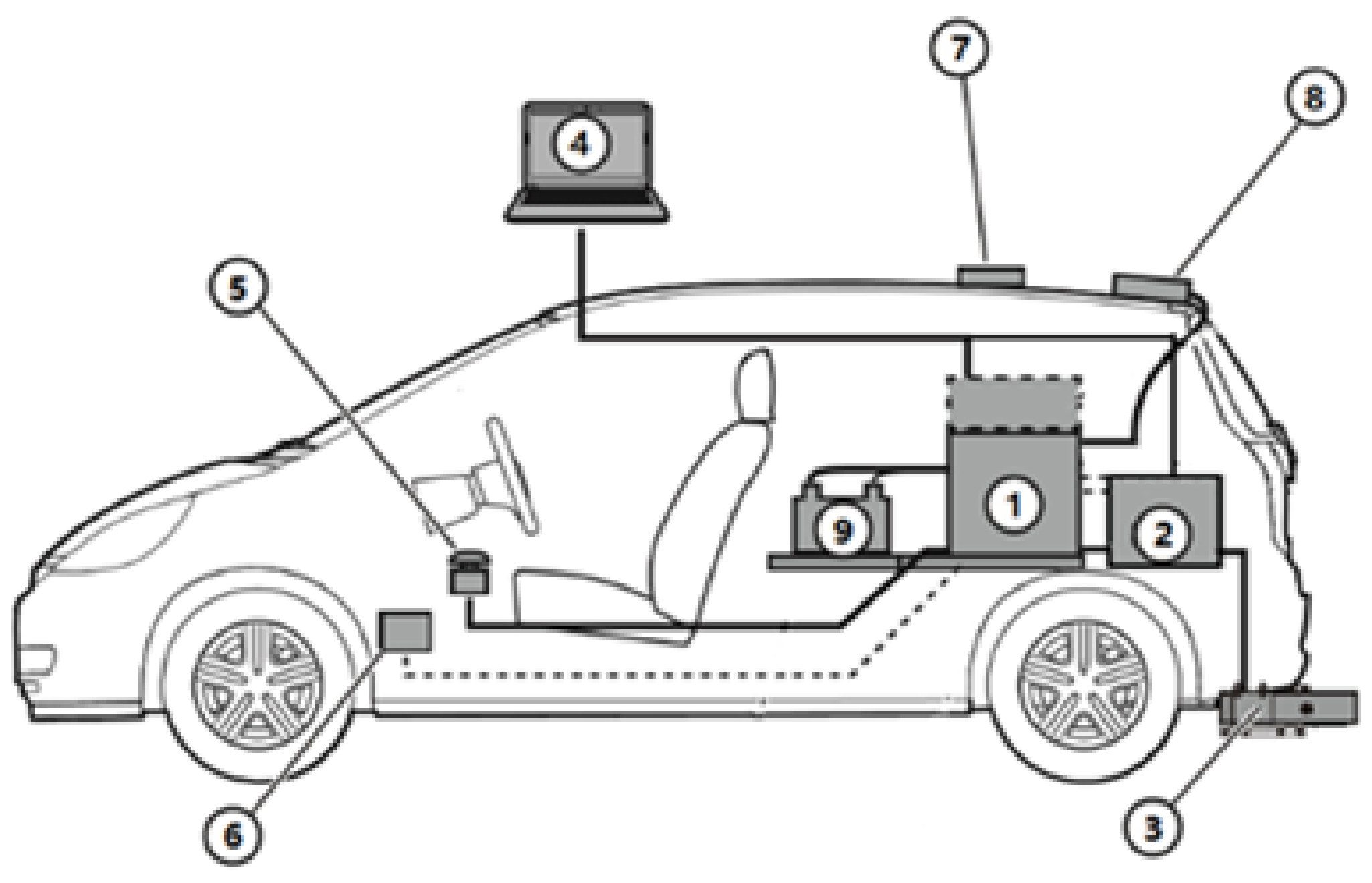
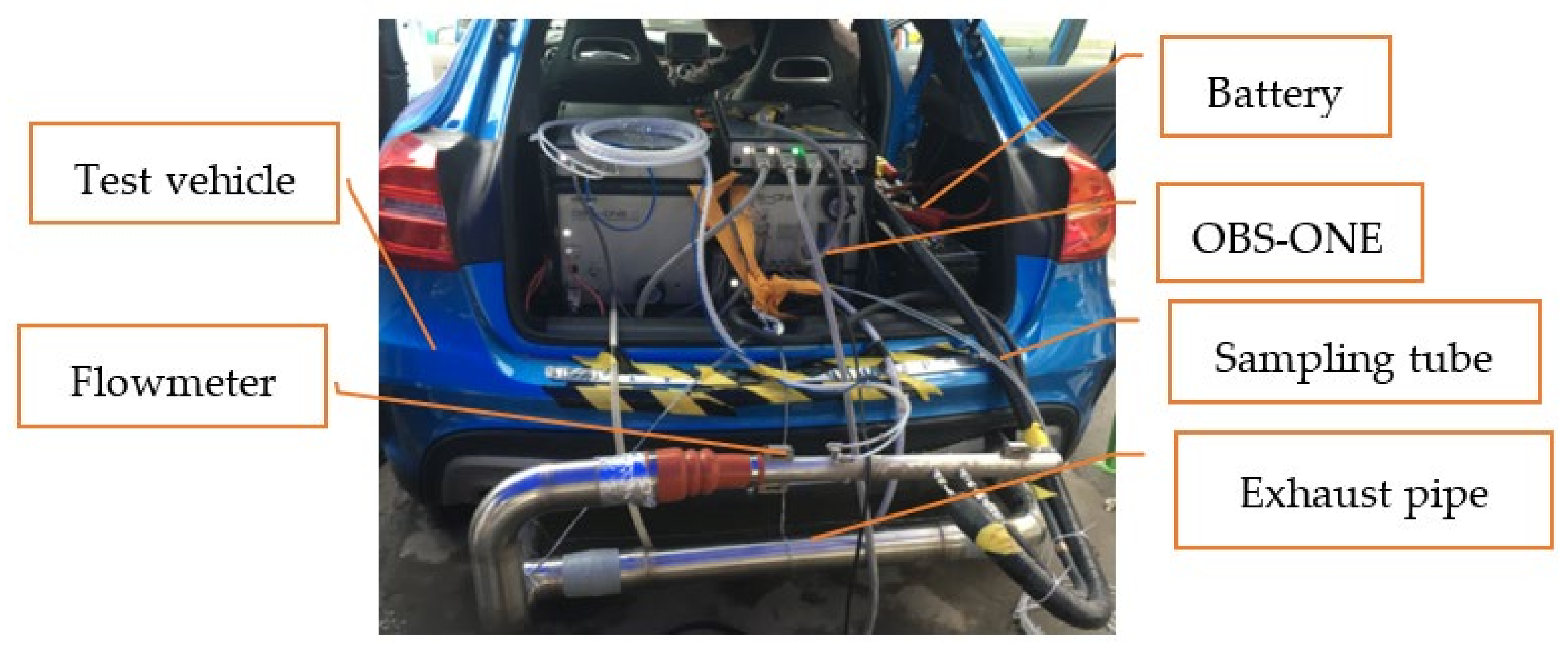
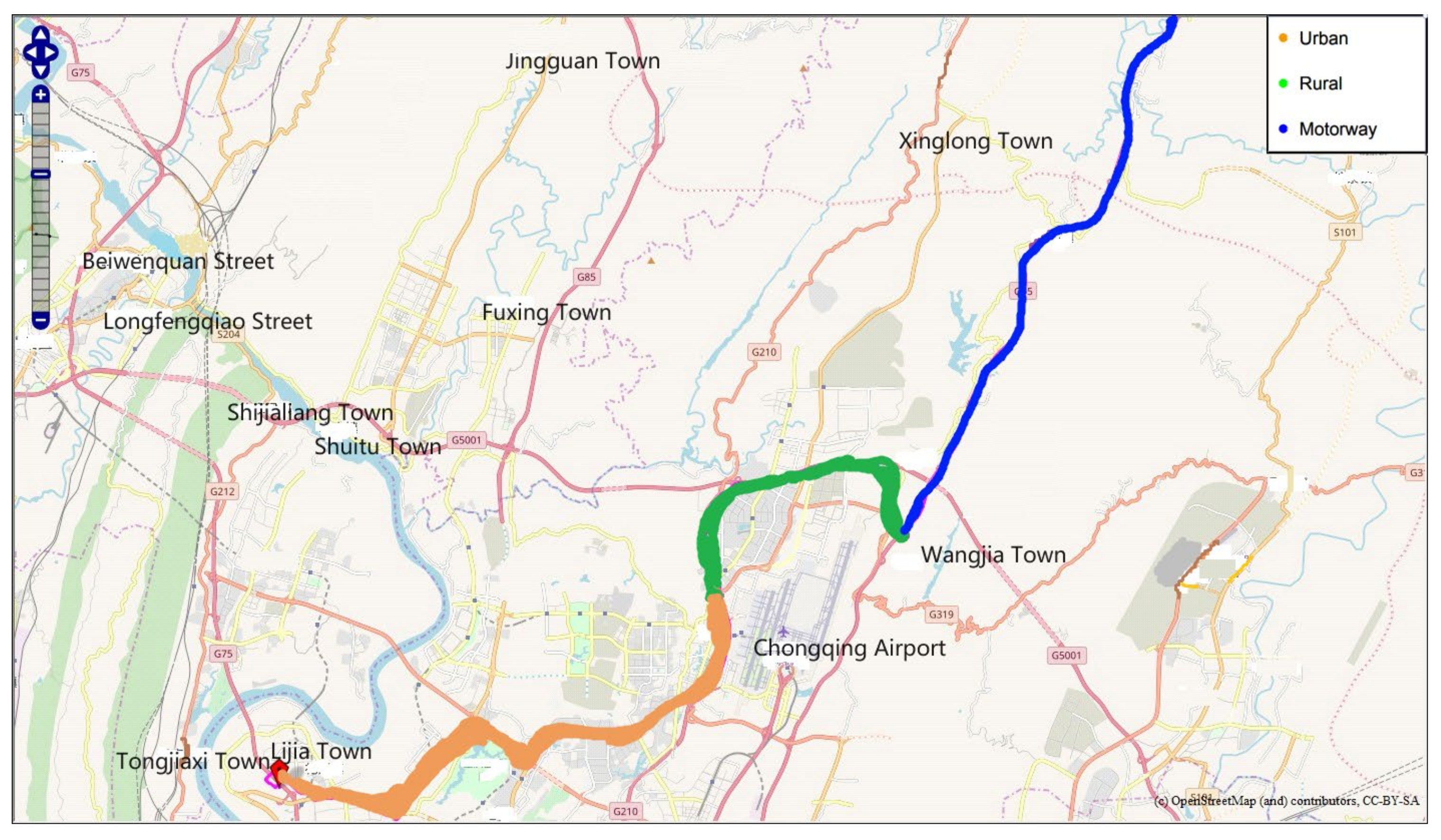
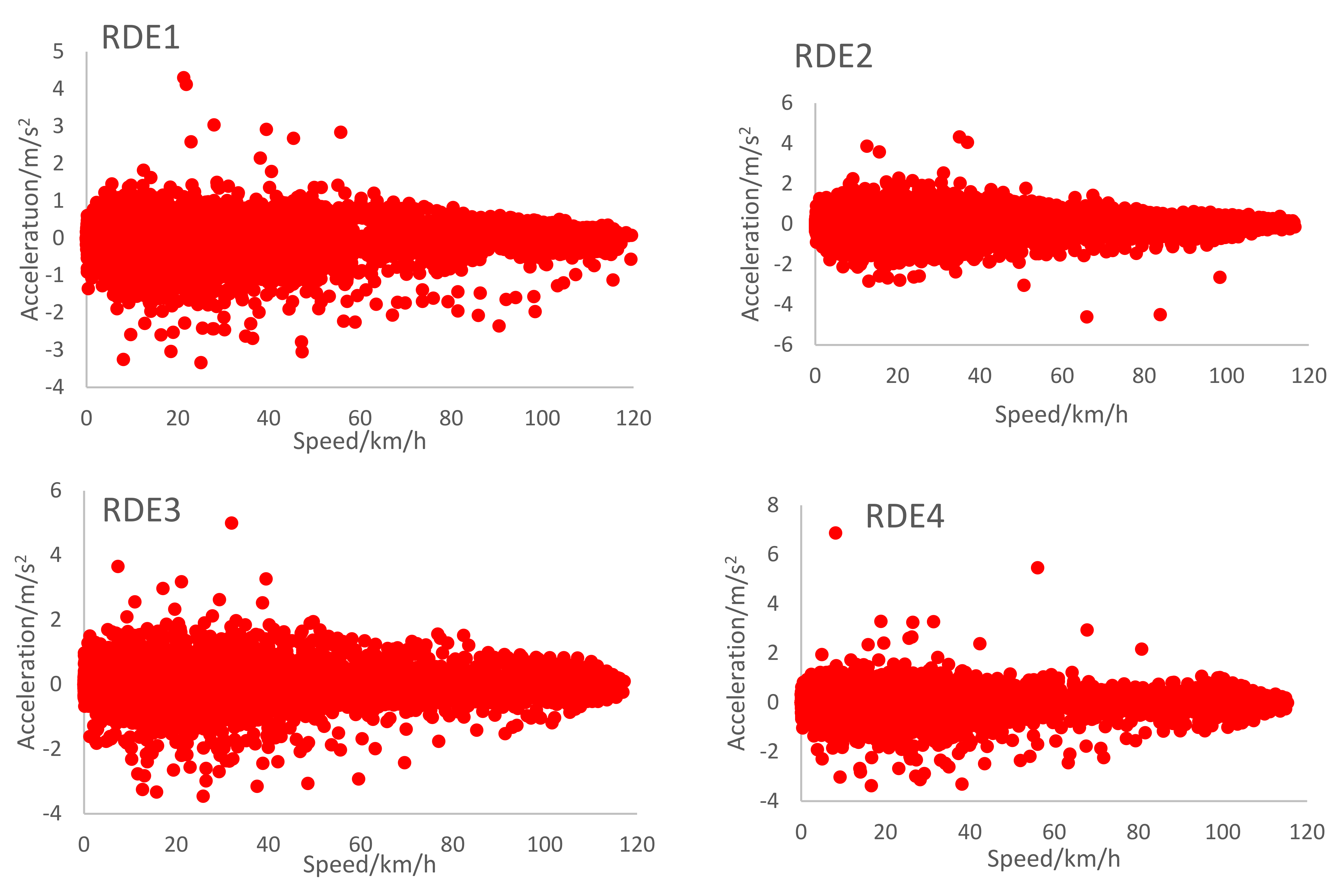

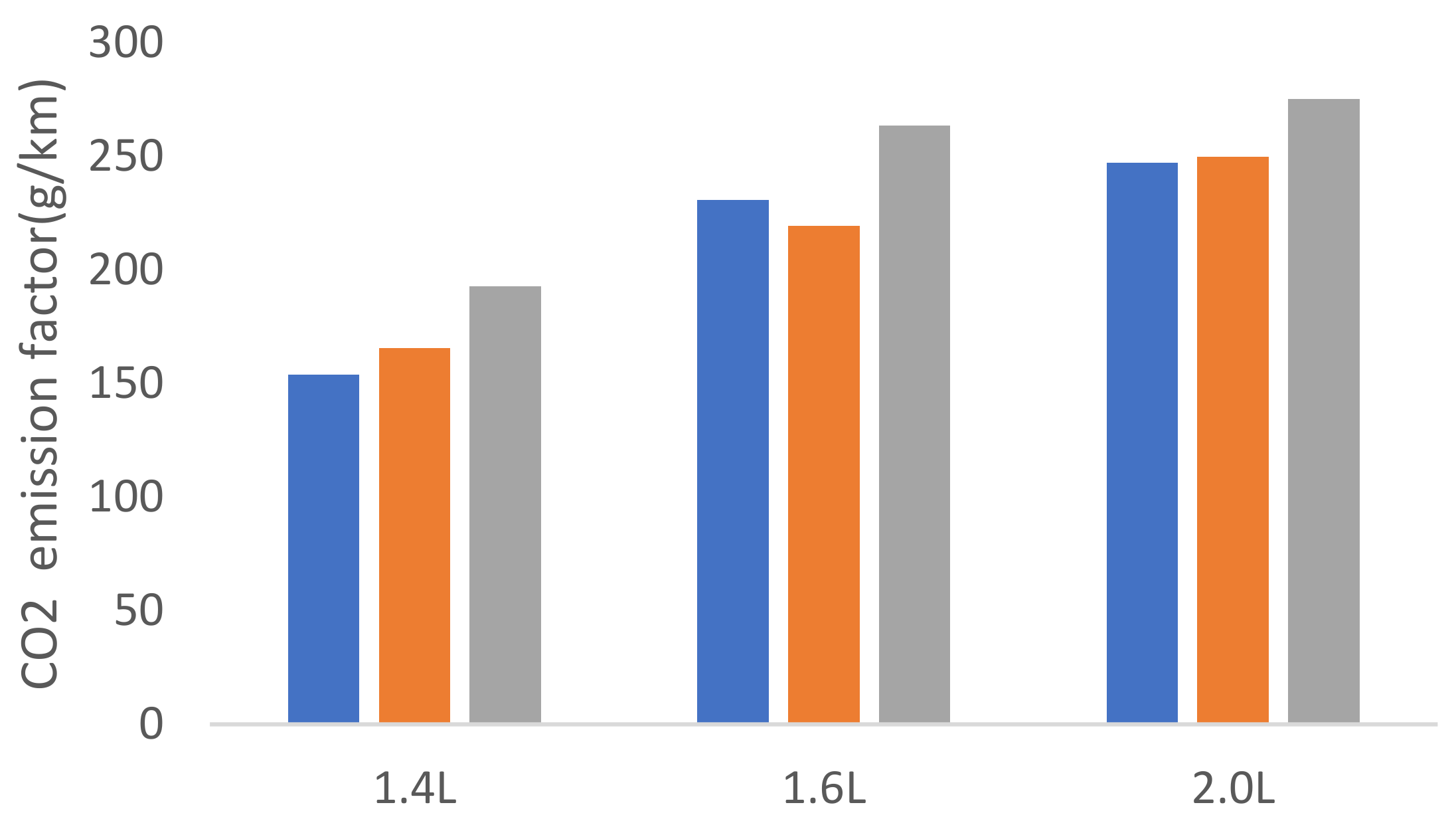


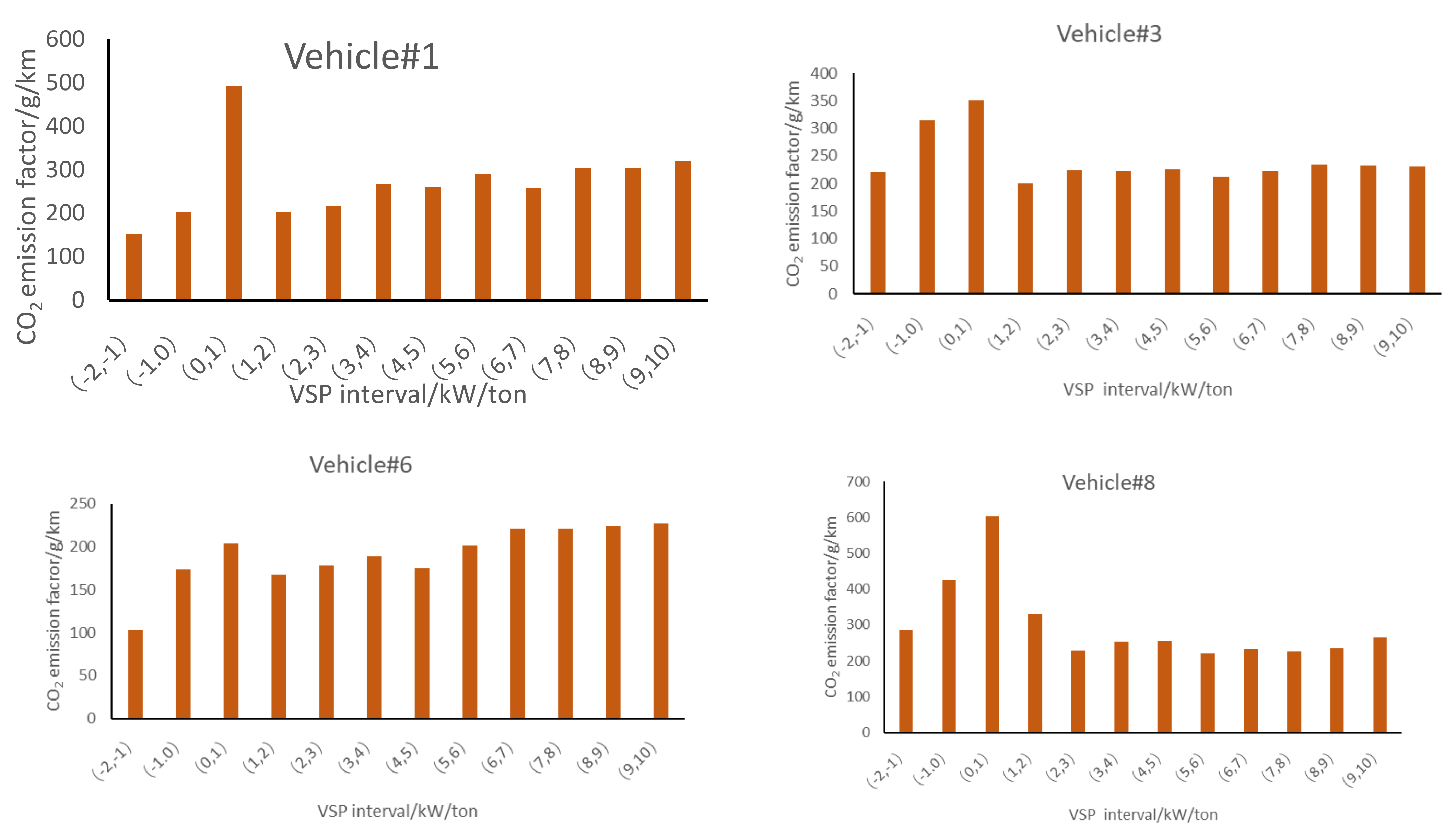
| Gaseous Pollutants | Measurement Principle | Measurement Range | Zero Gas | Measuring Distance Gas | Zero Gas/Measurement Distance Gas Pressure | Zero Gas/Measurement Distance Gas Flow | Measurement Error |
|---|---|---|---|---|---|---|---|
| CO | NDIR | 10 vol% | Synthetic air | gas mixture (CO + CO2 + C3H8 + NO/N2) and NO2 | 100 kPa ± 10 kPa | 2.5~4.0 L/min | ≤0.1 ppm |
| CO2 | NDIR | 20 vol% | |||||
| CO2 | CLD | 1600 ppm | |||||
| PN | CPC | ≤1% F.S |
| Projects | Conditions |
|---|---|
| Temperature | 0~40 °C |
| Humidity | Relative humidity below 80% |
| Ambient NOx concentration | Ambient NOx concentration less than 1 ppm |
| Power | Use a dedicated power supply without any voltage/swing oscillations |
| Ventilation | The exhaust of the system should be safely discharged to the outside environment |
| Maintenance space | Ample maintenance space outside the system |
| Wind and Rain | Waterproof Indoor |
| Electromagnetic field | The system must not be placed in a strong magnetic field |
| Maximum payload | Test vehicle load must be greater than the test system mass (including batteries and gas cylinders) |
| Test ID | Engine Type | Displacement/L | Power/kW | Torque/Nm | Aftertreatment | Mileage/km | Mass/kg |
|---|---|---|---|---|---|---|---|
| 1 | GDI | 2.0 | 167 | 380 | TWC + GPF | 4167 | 2145 |
| 2 | GDI | 2.0 | 167 | 380 | TWC + GPF | 8285 | 2187 |
| 3 | GDI | 2.0 | 171 | 380 | TWC + GPF | 955 | 2007 |
| 4 | GDI | 1.4 | 118 | 255 | TWC + GPF | 280 | 1390 |
| 5 | PFI | 1.6 | 90 | 152 | TWC + GPF | 3058 | 1715 |
| 6 | GDI | 1.6 | 145 | 275 | TWC + GPF | 3554 | 1610 |
| 7 | GDI | 1.6 | 145 | 275 | TWC + GPF | 3028 | 1610 |
| 8 | GDI | 1.6 | 145 | 275 | TWC + GPF | 3078 | 1580 |
| 9 | PFI | 1.5 | 80 | 141 | TWC + GPF | 5574 | 1335 |
| 10 | PFI | 1.5 | 115 | 207 | TWC | 3610 | 1610 |
| Projects | Speed/(km·h−1) | Mileage/km | Other Requirements |
|---|---|---|---|
| Urban | ≤60 | ≥16 | The actual speed of less than 1 km/h time accounted for 6–30% |
| Suburban | 60~90 | ≥16 | Suburban driving is allowed to be interrupted by urban driving |
| Highway | 90~120 | ≥16 | Vehicle speed above 100 km/h should reach at least 5 min or more |
Disclaimer/Publisher’s Note: The statements, opinions and data contained in all publications are solely those of the individual author(s) and contributor(s) and not of MDPI and/or the editor(s). MDPI and/or the editor(s) disclaim responsibility for any injury to people or property resulting from any ideas, methods, instructions or products referred to in the content. |
© 2023 by the authors. Licensee MDPI, Basel, Switzerland. This article is an open access article distributed under the terms and conditions of the Creative Commons Attribution (CC BY) license (https://creativecommons.org/licenses/by/4.0/).
Share and Cite
Xu, H.; Lei, Y.; Liu, M.; Ge, Y.; Hao, L.; Wang, X.; Tan, J. Research on the CO2 Emission Characteristics of a Light-Vehicle Real Driving Emission Experiment Based on Vehicle-Specific Power Distribution. Atmosphere 2023, 14, 1467. https://doi.org/10.3390/atmos14091467
Xu H, Lei Y, Liu M, Ge Y, Hao L, Wang X, Tan J. Research on the CO2 Emission Characteristics of a Light-Vehicle Real Driving Emission Experiment Based on Vehicle-Specific Power Distribution. Atmosphere. 2023; 14(9):1467. https://doi.org/10.3390/atmos14091467
Chicago/Turabian StyleXu, Hualong, Yi Lei, Ming Liu, Yunshan Ge, Lijun Hao, Xin Wang, and Jianwei Tan. 2023. "Research on the CO2 Emission Characteristics of a Light-Vehicle Real Driving Emission Experiment Based on Vehicle-Specific Power Distribution" Atmosphere 14, no. 9: 1467. https://doi.org/10.3390/atmos14091467
APA StyleXu, H., Lei, Y., Liu, M., Ge, Y., Hao, L., Wang, X., & Tan, J. (2023). Research on the CO2 Emission Characteristics of a Light-Vehicle Real Driving Emission Experiment Based on Vehicle-Specific Power Distribution. Atmosphere, 14(9), 1467. https://doi.org/10.3390/atmos14091467









